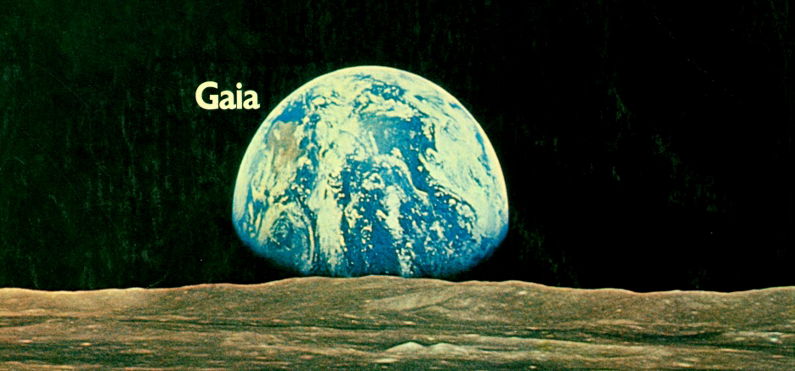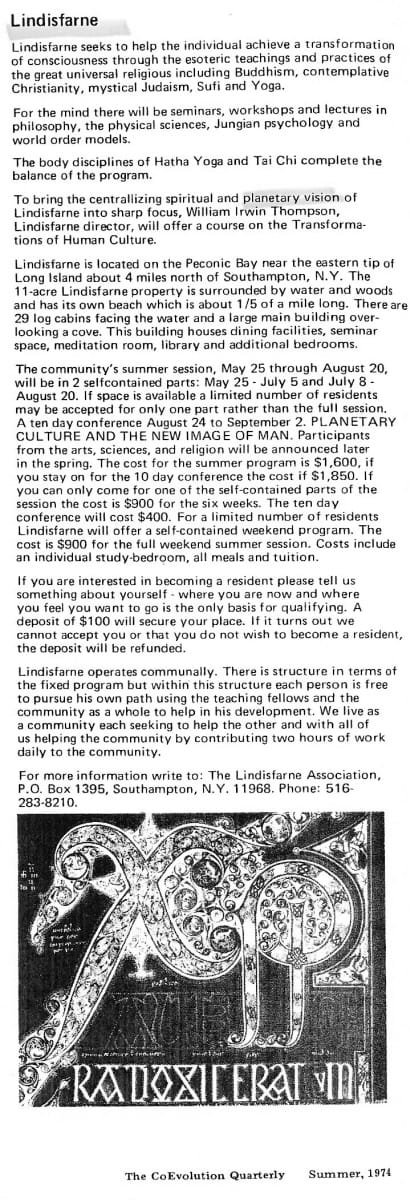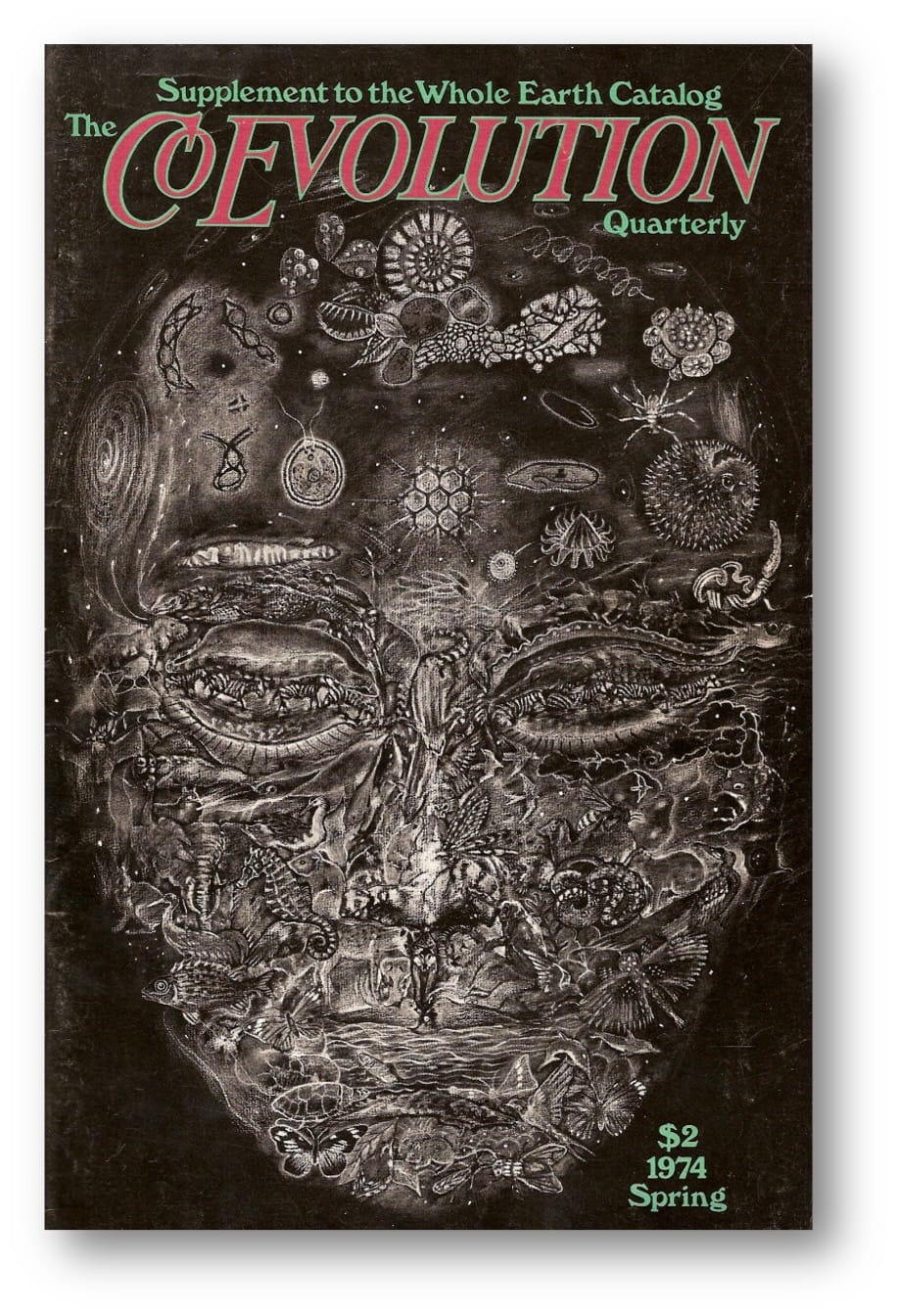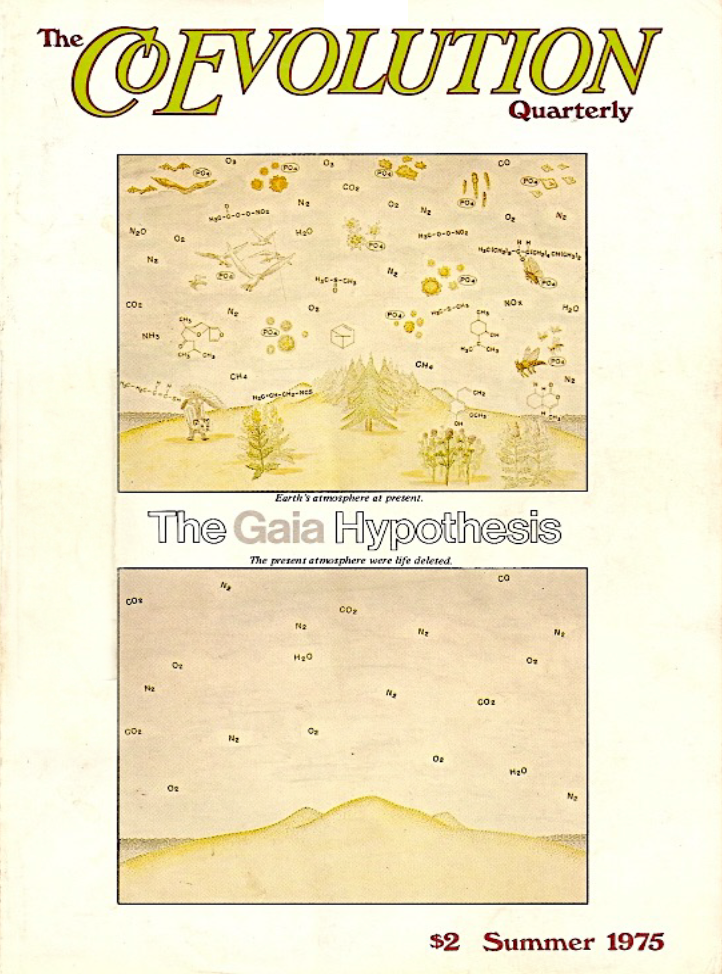Gaia in the Systems Countercultures

Bruno Clarke
The book project Systems Countercultures: Organic Cybernetics in the Whole Earth Era is examining a core of correspondents and interlocutors located at three separate but interrelated bases of operation that overlapped during the 1970s—the Whole Earth network, the Biological Computer Laboratory, and the Lindisfarne Association—in order to tell a new and important story within the wider history and collective development of cybernetic ideas.
Our initial point of reference is the Whole Earth Catalog (1968-71), its continuation in CoEvolution Quarterly (1974-84) and its inventor, educator and editor Stewart Brand (1938- ). His uniquely unwieldy textual creation centers our interest as a source for whole-systems thinking in its own right and also as a cultural matrix, a vibrant background and subcultural context. From the manifold of items contained in the Catalog, we will upload one crucial thematic component—the whole systems thread omnipresent in the first twenty years of the WEC’s many iterations and reformulations. This period closes when the Catalog project’s original cultivation of the ecological counterculture is effectively eclipsed, certainly not abandoned but relatively marginalized, by the gathering waves of cyberculture. I designate this period from 1968-87 as the Whole Earth era.
Brand’s correspondences with contributors on this systems thread trace the inner circle of a systems countercultures network. Its main players are cultural anthropologist Gregory Bateson (1904-1980); the director of the Biological Computer Lab, Heinz von Foerster (1911-2002); the Chilean neuroscientist Francisco Varela (1946-2001); microbiologist and evolutionary theorist Lynn Margulis (1938-2011); chemist and inventor James Lovelock (1919-2022); and poet, cultural historian, and Lindisfarne Association founder William Irwin Thompson (1938-2020). Brand’s Whole Earth operations provided a framework for the interaction of these particular systems thinkers, bringing them into contact, conversation, and correspondence in their turn.

For his part, William Irwin Thompson invited the members of this group to Lindisfarne gatherings; he then edited and published their proceedings. In some seminal instances, this was the network of exchanges that brought Bateson and Varela together at Lindisfarne in 1976 during a crucial moment in the latter’s early career, while a few years later, Varela and Margulis connected at a Lindisfarne conference, then corresponded with mutual impact on their biological thinking and science writing. Understanding the occasionally close relationships among these thinkers also deepens our grasp of their convergence upon a larger organic cybernetics proper to the first sensibility of the Whole Earth era. Given the current explosion of machine cybernetics at the altar of capital extraction, some counterbalance is vital. The organic mode of systems thinking is still compelling as both scientific description and epistemological guidance for doing technics in a living world. Systems Countercultures follows this alternative ecological route back through the larger history of cybernetics by tracing the web of personal and conceptual connections spun during the first iteration of the Whole Earth Catalog and CoEvolution Quarterly.
We note that theWhole Earth Catalog was never merely a lifestyle resource for hippies and communalists. It had all manner of brilliant expository content, frontloaded in every number by “Understanding Whole Systems,” which was at heart a cybernetics-themed book review section. Its spin-off CoEvolution Quarterly then evolves into a magazine that mixes a significant amount of article content with the WEC’s stock in trade, curated “objective” (non-commercial) product reviews with purchasing information. Being the first outlet to present the Gaia hypothesis and its authors to a non-specialist audience covers CQ in glory. Much the same goes for its extensive presentation of cutting-edge cybernetic content leaning to the organic side of those developments. This attention to organic cybernetics was the primary note struck by the Cybernetic Countercultures Intensive we at Gaian Systems led last fall through Gray Area. Note the emphatic statement to this effect early in Margulis and Lovelock's Gaia article in CQ: "We agree that the laws of physics and chemistry are basic to the understanding of atmospheric phenomena but insist that the laws of biology must be considered as well." Here's a piece of Gaian history as seen through its first Whole Earth appearance.

Carl Sagan put his ex-wife Lynn Margulis in touch with James Lovelock in 1970. In 1975, it was Sagan again who brought the Gaia hypothesis to the attention of Stewart Brand. That April, Margulis heard from Brand and passed the news along to Lovelock:
. . . Good news—and I’ll need a quick response . . . . Stewart Brand, editor of the CoEvolution Quarterly . . . has been pressuring me mightily, claims his mag. has a circulation of only 17,000. . . . Brand wants to do what looks like a whole issue on Gaia (vol. 6) . . . . He is claiming that his journal is responsible and responsive, refuses to compartmentalize science and that my accusation that he’s into food faddism and astrology is totally unfounded. . . . I told him that I could not give him permission unilaterally but must consult you. —Lynn Margulis to James Lovelock, April 29, 1975
"The Atmosphere as Circulatory System of the Biosphere: The Gaia Hypothesis" appears in summer 1975 as a lead article with artist's impressions of Gaian science commissioned by Margulis on the front and back covers.

Earth's atmosphere at present, outside front cover (legend on p.35): “Examples of major volatiles. . . . Spores of: ferns, club mosses, zygomycetes, ascomycetes, basidiomycetes, slime molds, bacteria. All contain nucleic acids and other organic phosphates, amino acids and so forth. Animal products: butyl mercaptan, plant products: myoporum, catnip (nepetalactone), eugenol, geraniol, penine, isothiocyanate (mustard); unknown; PAN (peroxacetyl nitrate), dimethyl sulphide, dimethyl sulfoxide; gases: nitrogen, oxygen, methane, carbon monoxide, carbon dioxide, ammonia."
The complex chemical diversity and far-from-equilibrium amalgam of reactive or "volatile" gases continuously resident in Earth's atmosphere is a Gaian signature, now generalized in the search for living exoplanets as a biosignature. In contrast, "The present atmosphere were life deleted" depicts a radically simplified, near-equilibrium scenario, the spent gases of a dead planet.
Immediately preceding the Gaia article proper is a two-page book review by Carl Sagan, “Three from Space,” recommending several volumes devoted to the space-age vista looking back at Earth from somewhere beyond it. This Earth-centered focus is not Sagan’s usual cosmic orientation! But here he seems to lend a hand by tracing the Gaian point of view.

In addition to the cover images, Margulis also secured the article’s frontispiece, Sachs von Lewenheimb’s 1664 engraving “Oceanus Macro-Microcosmicus,” to illustrate the Gaian analogy between the discovery of the circulation of the blood in the human body and the realization expressed as the Gaia hypothesis, that the circulation of the atmosphere is part of the “physiology” of a self-regulating planetary “body.”

We would like to discuss the Earth’s atmosphere from a new point of view – that it is an integral, regulated, and necessary part of the biosphere. . . . This new way of viewing the Earth’s atmosphere has been called the “Gaia” hypothesis. The term Gaia is from the Greek for “Mother Earth,” and it implies that certain aspects of the Earth's atmosphere—temperature, composition, oxidation reduction state, and acidity—form a homeostatic system, and that these properties are themselves products of evolution.

We agree that the laws of physics and chemistry are basic to the understanding of atmospheric phenomena but insist that the laws of biology must be considered as well. It is our contention that the paucity of overall understanding of certain aspects of the atmosphere, especially composition and temperature, is due to too narrow a paradigm: the idea that the atmosphere is an inert part of the inorganic environment and therefore amenable to methods of study that involve only physics and chemistry. . . .

In this paper we explore what is perhaps a more realistic view—that the atmosphere is a nonliving, actively regulated part of the biosphere. In our model atmospheric temperature and composition are regulated with respect to certain biologically critical substances: hydrogen ions, molecular oxygen, nitrogen and its compounds, sulfur and its compounds, and some others, whose abundance and distribution in the atmosphere are presumed to be under biological control. . . . The purpose of this paper is simply to present our reasons for believing the atmosphere is actively controlled. . . .
On lifeless planets there is no particular reason to expect this phenomenon of atmospheric cycling, nor on the earth is it expected that gases of elements that do not enter metabolism as either metabolites or poisons will cycle rapidly. . . . Because biological solutions to problems tend to be varied, redundant, and complex, it is likely that all the mechanisms of atmospheric homeostasis will involve complex feedback loops.

Pp. 36-37 nicely depict the disciplinary split between Margulis and Lovelock. As in the extract just given, Margulis narrates Gaia in terms of biological and ecological considerations of “circulation”: metabolism, growth, nutrient cycling and availability, and so on. However, under the subtitle “Gaia and Cybernetics,” Stewart Brand (presumably) splices in a long excerpt from a previous Gaia article lead-authored by Lovelock, in which the main considerations regarding “Life” are thermodynamic and information-theoretic. But the overriding argument here is Lynn's, centered on hypotheses regarding modes of biological regulation of planetary variables at arguably "optimal" values. Here is her closing argument:
The fossil evidence, taken together, suggests that the earth's troposphere has maintained remarkable constancy in the face of several enormous potential perturbations: at least the increase in solar luminosity and the transition to the oxidizing atmosphere. The earth atmosphere maintains chemical disequilibria of many orders of magnitude containing rapidly turning-over gases produced in prodigious quantities. The temperature and composition seem to be set at values that are optimal for most of the biosphere. Furthermore the biosphere has many potential methods for altering the temperature and composition of the atmosphere. The biosphere has probably had these methods available almost since its inception more than 3000 million years ago. Is it not reasonable to assume that the lower atmosphere is maintained at an optimum by homeostasis and that this maintenance (at the ultimate expense of solar energy, of course) is performed by the party with the vested interest: the biosphere itself?
CQ immediately follows Margulis’s lead-authored Gaia article with a review of her first book, Origin of Eukaryotic Cells, published in 1970. The contributor is the Beat poet and all-around wild man of letters Michael McClure:
Our scientists and social scientists have leaned heavily on a crude understanding of Darwin rather than on the subtleties of Darwin's thought. They have seen competition in all things. Margulis’ work should force every science to reexamine itself for gross error—such as she has discovered in biology. The social sciences which have always been crudely Darwinistic or Behavioristic should follow suit—and the same with the Arts.

Immediately following Margulis and Lovelock on the Gaia hypothesis and McClure's review is "Who's Earth," CQ content drawn from the first Lindisfarne Fellows meeting in the summer of 1974. The Whole Earth network's line to the Lindisfarne Association is a nucleus for the systems countercultures: Stewart Brand joined in alongside other early selections in William Irwin Thompson's curation of Lindisfarne Fellows—Gregory Bateson, John Todd, Francisco Varela, and a few years later, Lynn Margulis and James Lovelock. "Who's Earth" draws back into view the phenomenon that defines a major ambiance of the Whole Earth ethos—now called “the Overview Effect.” For this published transcript of a talk given by Rusty Schweickart, the hippie astronaut, Brand’s headnote reads: ”Like a prayer, like a benediction, Apollo 9 astronaut Russell Schweickart spoke these words last summer before a brainy group meeting on ‘Planetary Culture’ at the spiritual community of Lindisfarne, Long Island.”

You look down and see the surface of that globe that you've lived on all this time and you know all those people down there. They are like you, they are you, and somehow you represent them when you are up there —a sensing element, that point out on the end, and that's a humbling feeling. It's a feeling that says you have a responsibility. It's not for yourself.

The eye that doesn't see does not do justice to the body. That's why it's there, that's why you're out there. And somehow you recognize that you're a piece of this total life. You're out on that forefront and you have to bring that back, somehow. And that becomes a rather special responsibility. It tells you something about your relationship with this thing we call life. And so that's a change, that's something new.

Member discussion